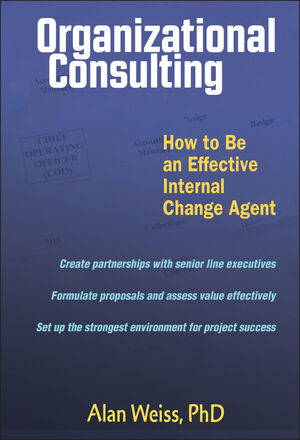Organizational Consulting: How to Be an Effective Internal Change AgentISBN: 978-0-471-26378-4
Hardcover
272 pages
February 2003
 This is a Print-on-Demand title. It will be printed specifically to fill your order. Please allow an additional 10-15 days delivery time. The book is not returnable.
|
||||||
Introduction.
PART I: THE ENVIRONMENT.
If It Walks Like A Duck: What Constitutes an Effective Internal Consultant?
Creating Peer Relationships: How to Be Perceived as a Credible Partner by Line Management.
Tools of the Trade: What You Must Possess to Avoid Being Thrown out the Door.
PART II: THE INTERACTIONS.
The Role of Conceptual Agreement: The Absolutely Best Way to Establish a Win/Win Project.
Formulating the Proposal: How to Ensure that You and the Buyer Meet Each Other's Expectations.
The Value Proposition: Why Every Client Knows What's Wanted but Not Necessarily What's Needed.
PART III: THE INTERVENTION.
The Pros and Cons of Living There: How to Maximize Strengths and Minimize Weaknesses.
The Politics of Terror: How to Reconcile Tough Issues without Being Drawn and Quartered.
Knowing When to Stop: How to Disengage, Give Credit, and (It's Allowed) Take Credit.
PART IV: THE AFTERMATH.
Assessing Value: How to Follow-Up and Leverage Your Success.
The Ethical Quandaries: When to Put Up, Shut Up, and Give Up.
More Suggested Rea dings.
Index.
About the Author.
PART I: THE ENVIRONMENT.
If It Walks Like A Duck: What Constitutes an Effective Internal Consultant?
Creating Peer Relationships: How to Be Perceived as a Credible Partner by Line Management.
Tools of the Trade: What You Must Possess to Avoid Being Thrown out the Door.
PART II: THE INTERACTIONS.
The Role of Conceptual Agreement: The Absolutely Best Way to Establish a Win/Win Project.
Formulating the Proposal: How to Ensure that You and the Buyer Meet Each Other's Expectations.
The Value Proposition: Why Every Client Knows What's Wanted but Not Necessarily What's Needed.
PART III: THE INTERVENTION.
The Pros and Cons of Living There: How to Maximize Strengths and Minimize Weaknesses.
The Politics of Terror: How to Reconcile Tough Issues without Being Drawn and Quartered.
Knowing When to Stop: How to Disengage, Give Credit, and (It's Allowed) Take Credit.
PART IV: THE AFTERMATH.
Assessing Value: How to Follow-Up and Leverage Your Success.
The Ethical Quandaries: When to Put Up, Shut Up, and Give Up.
More Suggested Rea dings.
Index.
About the Author.



